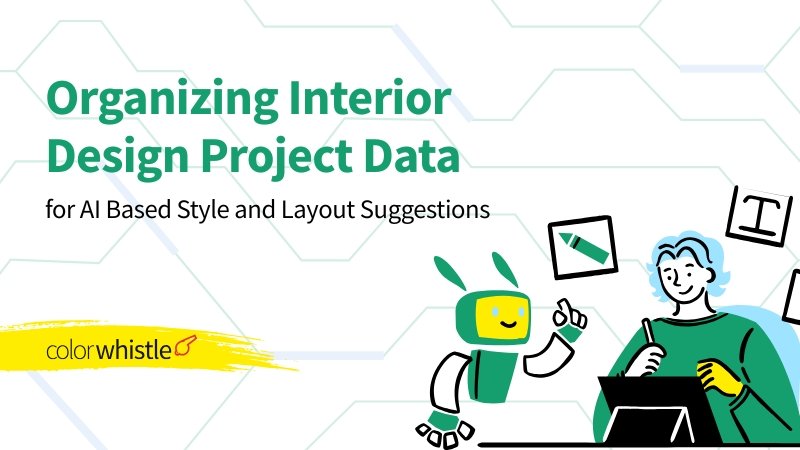In the world of interior design, organizing project data is crucial for using AI-based style and layout suggestions effectively. By carefully structuring information such as room sizes, client preferences, and design themes, designers can tap into the power of AI to improve their creative process.
This article will delve into the significance of organizing project data for AI in interior design and how it can lead to better design recommendations. We will also discuss the benefits of integrating digital marketing strategies into the interior design business to expand its reach.
Here are the key points we will cover:
- Understanding how to collect and structure design project inputs for effective AI utilization.
- Exploring different AI tools that aid in generating realistic visualizations and interactive models.
- Recognizing the benefits and challenges of integrating AI into interior design workflows.
- Anticipating future advancements in machine learning and AR/VR technologies that will shape the industry.
By the end of this article, you will have a clearer understanding of how organizing project data can unlock the potential of AI in delivering personalized style and layout solutions, ultimately enhancing both efficiency and creativity in interior design practices.
Collecting Design Project Inputs
Understanding the Role of Floor Plans in Project Data Collection
Floor plans are the foundational blueprints of any interior design project. They provide critical spatial information, including room dimensions, structural elements, and layout constraints. Accurately measuring and documenting these elements ensures that AI tools can generate realistic and optimized design suggestions.
Room dimensions: Precise measurements of length, width, and height for each room.
Structural elements: Locations of doors, windows, columns, and other architectural features.
Layout constraints: Identifying areas that need special attention due to their shape or size.
Using software like SketchUp or AutoCAD allows designers to create detailed digital floor plans that can be seamlessly integrated with AI tools for enhanced accuracy.
Also Read
Gathering Client Preferences for Personalized Design Solutions
Client preferences are essential for creating personalized interior design solutions. Capturing this data involves a combination of direct interviews, surveys, and interactive planning sessions. This information guides the AI in tailoring its recommendations to align with the client’s unique tastes and requirements.
Style preferences: Documenting preferred design styles such as minimalist, rustic, contemporary, or eclectic.
Functional needs: Understanding specific needs such as workspace requirements, storage solutions, or entertainment areas.
Color schemes: Identifying favored colors and palettes to ensure the final design aligns with client expectations.
Incorporating tools like digital questionnaires or interactive preference boards can streamline this process by systematically collecting relevant client inputs.
Creating Mood Boards to Capture the Desired Aesthetic Direction
Mood boards are visual collages that convey the desired aesthetic direction of a project. They play a crucial role in organizing project data by capturing the essence of what the client envisions. Mood boards typically include images, color swatches, material samples, and inspirational themes.
- Visual inspiration: Curating images that reflect the desired style and ambiance.
- Color swatches: Displaying selected color palettes to guide design choices.
- Material samples: Including textures and finishes that resonate with the client’s vision.
- Inspirational themes: Highlighting motifs or concepts that define the project’s aesthetic framework.
Creating mood boards can be done using physical materials or digital platforms like Pinterest or Canva, allowing for easy sharing and collaboration between designers and clients.
By meticulously gathering these inputs through well-defined processes floor plans, client preferences, and mood boards, designers lay a robust foundation for AI tools to generate precise style and layout suggestions tailored to individual projects.
In addition to these traditional methods of data collection, leveraging advanced technology such as website redesign services can significantly enhance the overall design process. For instance, a website redesign can revamp a designer’s online portfolio, making it more user-friendly while also optimizing it for search engines. This not only showcases their work effectively but also attracts more potential clients by improving online visibility.
Structuring Visual Data for AI Tools
Exploring the Capabilities of Midjourney in Generating Realistic Interior Visualizations
Midjourney is changing how interior designers see their projects. Using advanced AI algorithms, it can create very realistic interior visualizations based on the data provided. This tool lets designers look at different design choices without physically changing the space.
Key Features of Midjourney
- Realistic Renderings: Midjourney provides photorealistic renderings that capture intricate details such as textures, lighting, and spatial depth. These renderings help clients envision the final outcome more accurately.
- Dynamic Adjustments: Designers can make dynamic adjustments to elements like furniture placement, color schemes, and decor items. Midjourney adapts these changes in real-time, showcasing immediate results.
- Enhanced Creativity: With Midjourney’s capabilities, designers can experiment with bold ideas and unconventional styles. This fosters creativity while ensuring practical viability through realistic visual feedback.
Utilizing Planner 5D for Creating Interactive 3D Models and Virtual Tours
Planner 5D is a powerful tool that transforms traditional floor plans into interactive 3D models and virtual tours. It bridges the gap between conceptual design and physical realization by providing a detailed, immersive experience.
Features of Planner 5D
- Interactive 3D Models: Planner 5D allows designers to create detailed 3D models of interiors. These models provide a comprehensive view of spatial arrangements, enabling designers to assess functionality and aesthetics simultaneously.
- Virtual Tours: Virtual tours created with Planner 5D offer an immersive experience where clients can navigate through the space as if they were physically present. This helps in understanding the flow and feel of the design before any physical changes are made.
- Customizable Elements: Designers can customize every aspect of the model, from wall colors to furniture styles, ensuring that the final design aligns perfectly with client preferences. Planner 5D’s extensive library of decor elements supports this customization process.
Integrating Visual Data into AI Systems
To get the most out of tools like Midjourney and Planner 5D, it’s important to integrate their outputs into AI systems effectively.
Strategies for Integration
- Data Structuring: Organize visual data into categories such as spatial measurements, stylistic elements, and functional needs. Tagging items with metadata like color codes or material types aids in seamless integration.
- Database Management: Maintain a database that supports easy retrieval and updating of project components. Structured visual data enables AI tools to analyze inputs efficiently and offer personalized design recommendations.
By carefully organizing visual data, interior designers can use AI tools for better accuracy, efficiency, and creativity. This method ensures that every project not only meets but exceeds client expectations while optimizing resources and time.
Furthermore, incorporating 3D room configurators into this mix can significantly enhance user experience and engagement by allowing clients to visualize products within their own spaces before making a purchase decision.
Using AI to Generate Layouts and Style Matches
AI is transforming the way interior designers work by automating tasks that were once time-consuming and manual. Two key areas where AI is making a significant impact are:
Automating Furniture Layouts: AI algorithms can analyze room dimensions, user preferences, and other factors to generate optimal furniture arrangements.
Exploring Design Styles: AI visual tools enable designers to explore various design styles and identify furniture pieces that complement each other visually.
In this section, we’ll explore how these technologies are being used in the field of interior design.
Automating Furniture Layouts with AI Algorithms
AI algorithms are changing the way interior designers approach furniture layouts. These advanced systems can automate the process of generating optimal arrangements by analyzing spatial constraints and user preferences.
How AI Algorithms Work
Here’s how AI algorithms work in automating furniture layouts:
Spatial Analysis: AI tools assess room dimensions, existing architectural features, and flow patterns to ensure that furniture placement enhances functionality and aesthetics.
User Preferences: Incorporating client inputs such as preferred styles, color schemes, and desired ambiance allows AI to tailor layouts that resonate with personal tastes.
For example, an AI-powered platform might recommend a cozy reading nook in a corner where natural light is abundant or suggest a minimalist workspace setup for a home office.
Exploring Design Styles with AI Visual Tools
AI visual tools play a crucial role in helping interior designers explore various styles and identify furniture pieces that complement each other visually.
How AI Visual Tools Work
Here’s how AI visual tools work in exploring design styles:
Style Exploration: Through machine learning algorithms, AI can present multiple design styles ranging from modern minimalism to bohemian chic. This enables clients to visualize different aesthetics before making decisions.
Complementary Pieces: Leveraging databases of furniture items tagged by style, material, color, and texture helps in curating cohesive designs. For example, once a client selects a Scandinavian-style sofa, the AI tool might suggest matching wooden coffee tables or neutral-toned rugs.
AI visual tools like Decorilla and InteriorAI are particularly adept at providing photorealistic renderings that bring potential designs to life. These platforms offer interactive features allowing clients to tweak elements in real-time.
Practical Examples
Consider an interior designer tasked with redesigning a compact urban apartment:
Layout Automation: The designer inputs room dimensions into an AI tool which then suggests optimal placement for essential furniture pieces while maximizing space efficiency.
Style Matches: Using an AI visual tool, the designer explores several contemporary styles. The client selects mid-century modern – the tool then recommends complementary items like sleek walnut sideboards and retro lighting fixtures.
By merging layout automation with style exploration capabilities, designers can provide highly personalized solutions quickly and efficiently.
In this section, we’ve explored how AI algorithms can automate furniture layouts based on spatial constraints and user preferences, while AI visual tools enable exploration of various design styles and identification of complementary furniture pieces. The integration of these technologies streamlines the design process significantly.
Moreover, it’s worth noting that just as these advanced systems are revolutionizing interior design, similar AI-powered solutions are being employed in other sectors such as education for maintaining websites efficiently while ensuring they remain fast, secure, and accessible.
Benefits of Organizing Project Data for Studios and Design SaaS Tools
Optimizing the way project data is structured and managed unlocks a new level of efficiency and creativity for interior design studios and SaaS platforms. The transformation begins not with the AI itself, but with how information spatial measurements, style preferences, furniture inventories, and lighting conditions is captured and categorized.
Streamlined Design Process
A well-organized data foundation acts as an engine for rapid iteration and smart decision-making. Studios can:
- Automate Repetitive Tasks: Tagging layouts, color palettes, and furniture types enables AI to quickly assemble options instead of requiring manual sorting.
- Accelerate Concept-to-Render Workflow: With precise room dimensions and product details ready in structured formats, generating 3D models or photorealistic renders becomes almost instantaneous.
- Reduce Errors and Redundancies: Clarity in spatial data minimizes rework caused by measurement mistakes or missing information, cutting both costs and project timelines.
- Effortless Collaboration: Teams access shared databases where every material swatch, client note, or layout version is instantly available, creating seamless handoffs between designers, project managers, and clients.
Imagine a studio that moves from initial consultation to mood board to interactive 3D walkthrough, all in days instead of weeks. This speed not only delights clients but also allows firms to handle more projects without sacrificing quality.
Enhanced Personalization Through Data-Driven Insights
Intelligent organization of project data transforms generic AI suggestions into deeply personalized design recommendations. As diverse data sets accumulate, ranging from client surveys to annotated mood boards, AI tools evolve their understanding of both broad trends and individual quirks.
- Adaptive Style Matching: By analyzing historical choices across projects, AI recognizes patterns unique to each client’s taste. For example, A preference for matte finishes or Scandinavian-inspired minimalism.
- Contextual Recommendations: The system interprets functional needs (like optimizing natural light for home offices) alongside aesthetic desires. This blend ensures solutions aren’t just beautiful, they’re livable.
- Continuous Learning: Each new project refines the model further. Over time, the platform automatically suggests color schemes or furniture arrangements that echo a client’s evolving style profile.
- Localized Curation: For SaaS providers serving global audiences, organized data enables the tailoring of recommendations based on regional trends or locally available materials.
“A personalized experience isn’t just about picking the right chair—it’s about understanding why that chair feels right in that room for that person.”
As project data grows richer and more interconnected within SaaS ecosystems, the leap from inspiration to implementation shrinks. Studios wielding these tools find themselves at the forefront of bespoke design at scale, where every client feels seen, every project is unique, and creativity flourishes on a foundation of precision.
Challenges in Implementing AI-Based Style and Layout Suggestions
Integrating AI into the interior design workflow opens up exciting creative opportunities, but it also comes with its own set of challenges that need careful handling. Two main concerns often arise: misinterpretation by AI systems and the inherent limitations in replicating creativity and emotion.
Misinterpretation by AI Systems
AI works best with structured data, but even with well-organized inputs, these systems can still have trouble understanding the complexities of real-world spaces or highly personalized client requests. Here are some common situations where misinterpretation can happen:
- Ambiguous Floor Plans: Overly simplified or unclear spatial diagrams can lead AI to generate layouts that ignore architectural features like sloped ceilings or irregular room shapes.
- Nuanced Instructions: Clients may express desires in abstract terms “cozy but modern,” or “a hint of industrial without feeling cold.” Without rich context or past project references, AI might default to generic interpretations, missing the intended vibe.
- Multi-functional Spaces: Rooms that serve multiple purposes (e.g., a home office doubling as a guest room) challenge algorithms that rely on single-use room categorizations, sometimes resulting in impractical furniture placements.
For example
An automated tool may place a bulky sofa directly under a window, disregarding both the natural light source and the client’s preference for unobstructed views.
Limitations in Replicating Creativity and Emotion
While AI is great at spotting patterns and suggesting arrangements based on existing data, it struggles when trying to imitate the artistic flair and intuition of human designers. Here are some common issues:
- Surface-Level Style Matching: Algorithms analyze color schemes, furniture shapes, and material choices, but often miss out on understanding cultural context or personal narratives that give a space character.
- Emotional Understanding: Human designers pick up on subtle signals body language during meetings, emotional responses to samples that guide deeply personalized decisions. Current AI models work on logic and probabilities, lacking empathy.
- Creative Solutions: When faced with unexpected site challenges (like fitting in sentimental heirlooms or accommodating changing family needs), human resourcefulness shines. AI tends to stick to its programmed limits, sometimes suggesting solutions that feel mechanical.
“The magic of design lives between the lines—where memories are made tangible through space. That’s still something no algorithm can reliably capture.”
Navigating These Challenges
Design studios using AI-powered tools are trying out mixed workflows:
Using AI for initial concepts while relying on designer review for emotional depth
Training custom models on curated portfolios to better match studio styles
Creating feedback loops so each project helps improve future recommendations
This combination of structured automation and intuitive artistry is changing how interior spaces develop. The journey continues as technology advances, and as designers teach their digital counterparts what truly makes a space feel like home.
Future Directions for Research and Development in this Field
The rapid evolution of machine learning algorithms and the creative convergence of digital experiences are opening new frontiers in Organizing Interior Design Project Data for AI-based style and Layout Suggestions. As researchers and developers push boundaries, several promising paths are emerging to refine how AI understands, generates, and enhances interior spaces.
Advancements in Machine Learning Algorithms
AI’s capacity to interpret nuanced spatial relationships and style preferences is climbing to new heights with each leap in machine learning. Upcoming research is poised to:
- Deepen Contextual Understanding: Next-generation algorithms may leverage contextual embeddings that capture not just the dimensions and furniture types, but also subtleties like atmosphere, mood, or cultural symbolism. Imagine an AI distinguishing between “mid-century calm” and “mid-century playful” based on color palettes, form language, and even user sentiment expressed through feedback.
- Adaptive Style Transfer: Enhanced neural networks could allow real-time adaptation of inspiration images or mood boards directly onto a user’s unique floor plan, automatically adjusting layouts to fit odd-shaped rooms or combining multiple style influences without losing coherence.
- Learning from Feedback Loops: Machine learning systems trained on iterative feedback, such as client ratings or designer revisions, can become more adept at predicting preferences and avoiding previous inefficiencies. The future will likely bring AIs that develop an almost intuitive sense for a client’s evolving taste over time.
Also Read
Integration of AR/VR Technologies into Interior Design Workflows
Immersive technologies are set to transform how stakeholders experience design suggestions before a single piece of furniture is moved.
- AR-Powered Onsite Visualization: Clients can use smartphones or AR glasses to superimpose proposed layouts or finishes directly onto their actual living spaces. This hands-on preview bridges imagination and reality, helping clients make confident decisions.
- VR-Based Collaborative Sessions: Virtual reality platforms enable designers, clients, and contractors to enter a fully navigable 3D environment together, regardless of physical location. Real-time collaboration means switching out materials, trying new configurations, or adjusting lighting with instant visual feedback.
- Data-Rich Interaction Tracking: As users interact with virtual environments, lingering over certain vignettes, ignoring others, the system collects valuable behavioral data. This information can feed back into the project database, refining future AI suggestions for even greater personalization.
Expanding the Boundaries: From Data Organization to Experiential Design
Organizing Interior Design Project Data for AI-Based Style and Layout Suggestions is evolving from a technical necessity into a catalyst for creative exploration. With smarter algorithms parsing richer datasets and immersive technologies making design tangible at every stage, the distinction between what is imagined and what is possible continues to blur.
The intersection of these innovations suggests an era where interior design becomes not only more efficient but also more emotionally resonant, shaped by data yet deeply human in its outcomes.
Conclusion
Efficient workflows in interior design projects depend on the meticulous organization of project data. Every floor plan, client preference, and aesthetic reference forms the foundation that enables AI to generate style and layout suggestions tailored to individual visions. When data is structured, tagged, and easily retrievable, advanced AI tools can unlock creative possibilities, transforming abstract ideas into immersive visualizations and actionable plans.
“The synergy between human creativity and intelligent automation marks the new frontier of interior design.”
Embracing this approach invites every designer to:
- Prioritize data accuracy and structure: Ensure every detail from room measurements to material palettes is precisely recorded.
- Leverage technology as a creative partner: Use AI’s analytical strength to inspire new layouts, while letting your intuition guide the final touch.
- Foster continuous learning: Stay open to emerging tools that streamline collaboration and enhance client experience.
A future where Organizing Interior Design Project Data for AI-based style and Layout Suggestions becomes standard practice will empower studios and freelancers alike. The result: more imaginative spaces, happy clients, and truly efficient workflows ready to meet the challenges of tomorrow’s design landscape. This includes embracing AI workflow automation for retail, which enhances efficiency through smart integration with management systems, streamlining operations, and boosting productivity.
FAQs (Frequently Asked Questions)
Why is organizing interior design project data important for AI-based style and layout suggestions?
Organizing project data is crucial as it enhances the accuracy and relevance of AI-driven design recommendations. Efficient data structuring allows AI tools to analyze floor plans, client preferences, and mood boards effectively, leading to personalized and optimized interior design solutions.
How do floor plans, client preferences, and mood boards contribute to collecting design project inputs?
Floor plans provide spatial context necessary for layout automation, client preferences guide personalized style choices, and mood boards capture the desired aesthetic direction. Together, they form a comprehensive dataset that AI tools use to generate tailored interior design suggestions.
What roles do AI tools like Midjourney and Planner 5D play in structuring visual data for interior design?
Midjourney excels at generating realistic interior visualizations, helping designers preview styles, while Planner 5D enables the creation of interactive 3D models and virtual tours. Both tools structure visual data to facilitate immersive and accurate design presentations powered by AI.
How does AI automate layout generation and style matching in interior design projects?
AI algorithms analyze spatial constraints from floor plans and user preferences to automate optimal furniture layouts. Additionally, AI visual tools explore various design styles and identify furniture pieces that complement each other visually, streamlining the decision-making process.
What are the benefits of organizing project data for studios and design SaaS tools using AI?
Organized project data streamlines the design process by reducing timelines and costs. It also enables enhanced personalization as AI learns from diverse datasets to adapt to individual client tastes, resulting in more tailored and effective interior design solutions.
What challenges exist in implementing AI-based style and layout suggestions in interior design?
Challenges include potential misinterpretation of complex spatial arrangements or unique client instructions by AI systems, which can lead to suboptimal outcomes. Moreover, current AI technologies have limitations in fully replicating the nuanced creativity and emotional depth provided by human designers.





